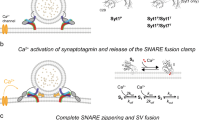Abstract
This review describes the development of the molecular level Ca2+-voltage hypothesis. Theoretical considerations and feedback between theory and experiments played a key role in its development. The theory, backed by experiments, states that at fast synapses, membrane potential by means of presynaptic inhibitory autoreceptors controls initiation and termination of neurotransmitter release. A molecular kinetic scheme which depicts initiation and termination of evoked release is discussed. This scheme is able to account for both spontaneous release and evoked release. The physiological implications of this scheme are enumerated.
Similar content being viewed by others
References
Aharon, S., 1996. Parallel computation enables precise description of Ca2+ distribution in nerve terminals. Bull. Math. Biol. 58, 1075–1097.
Andreu, R., Barrett, E.F., 1980. Calcium dependence of evoked transmitter release at very low quantal contents at the frog neuromuscular junction. J. Physiol. (Lond.) 308, 79–97.
Atwood, H.L., Wojtowicz, J.M., 1986. Short-term and long-term plasticity and physiological differentiation of crustacean motor synapses. Int. Rev. Neurobiol. 28, 275–362.
Augustine, G.J., Charlton, M.P., Smith, S.J., 1987. Calcium action in synaptic transmitter release. Annu. Rev. Neurosci. 10, 633–693.
Ben-Chaim, Y., Tour, O., Dascal, N., Parnas, I., Parnas, H., 2003. The M 2 muscarinic G-protein-coupled receptor is voltage-sensitive. J. Biol. Chem. 278(25), 22482–22491.
Bollman, J.H., Sackmann, B., Borst, J.G., 2000. Calcium sensitivity of glutamate release in a calyx-type terminal. Science 289, 953–957.
Dodge, F.A., Rahamimmoff, R., 1967. Co-operative action a calcium ions in transmitter release at the neuromuscular junction. J. Physiol. (Lond.) 193, 419–432.
Datyner, N.B., Gage, P.W., 1980. Phasic secretion of acetylcholine at a mammalian neuromuscular junction. J. Physiol. (Lond.) 303, 299–314.
Heidelberger, R., Heinemann, C., Neher, E., Matthews, G., 1994. Calcium dependence of the rate of exocytosis in a synaptic terminal. Nature 371(6497), 513–515.
Ilouz, N., Branski, L., Pranis, J., Parnas, H., Linial, M., 1999. Depolarization affects the binding properties of muscarinic acetylcholine receptors and their interaction with proteins of the exocytic apparatus. J. Biol. Chem. 274, 29519–29528.
Kasai, H., 1999. Comparative biology of Ca2+-dependent exocytosis: implications of kinetic diversity for secretory function. Trends Neurosci. 22, 88–93.
Katz, B., 1969. The Release of Neural Transmitter Substances. Liverpool University Press, Liverpool.
Khanin, R., Parnas, H., Segel, L.A., 1997. First step negative feedback accounts for inhibition of fast neurotransmitter release. J. Theor. Biol. 188, 261–276.
Linial, M., Ilouz, N., Parnas, H., 1997. Voltage-dependent interaction between the muscarinic ACh receptor and proteins of the exocytic machinery. J. Physiol. (Lond.) 504, 251–258.
Llinás, R., 1977. Calcium and transmitter release in squid synapse. Soc. Neurosci. Symp. 2, 139–160.
MacDermott, A.B., Role, L.W., Siegelbaum, S., 1999. Presynaptic ionotropic receptors and the control of transmiter release. Annu. Rev. Neurosci. 22, 443–485.
Parnas, I., Dudel, J., Parnas, H., Ravin, R., 1996. Glutamate depresses release by activating nonconventional glutamate receptors at crayfish nerve terminals. Eur. J. Neurosci. 8, 116– 126.
Parnas, H., Parnas, I., 1994. Neurotransmitter release at fast synapses. J. Membr. Biol. 142, 267–279.
Parnas, H., Parnas, I., Ravin, R., Yudelevitch, B., 1994. Glutamate and N-methyl-D-asparate affect release from crayfish axon terminals in a voltage-dependent manner. Proc. Natl. Acad. Sci. USA 91, 11586–11590.
Parnas, H., Parnas, I., Segel, L., 1986. A new method for determining co-operativity in neurotransmitter release. J. Theor. Biol. 119, 481–499.
Parnas, H., Parnas, I., Segel, L.A., 1990. On the contribution of mathematical models to the understanding of neurotransmitter release. Int. Rev. Neurobiol. 32, 1–50.
Parnas, H., Segel, L.A., Dudel, J., Parnas, I., 2000. Autoreceptors, membrane potential and the regulation of transmitter release. Trends Neurosci. 23(2), 60–68.
Parnas, H., Slutsky, I., Rashkovan, G., Silman, I., Wess, J., Parnas, I., 2005. Depolarization initiates phasic ACh release by relief of a tonic block imposed by presynaptic M2 muscarinic receptors. J. Neurophysiol. 93, 3257–3269.
Parnas, H., Valle-Lisboa, J.C., Segel, L.A., 2002. Can the Ca2+ hypothesis and the Ca2+-voltage hypothesis for neurotransmitter release be reconciled? Proc. Natl. Acad. Sci. USA 99(26), 17149–17154.
Schneggebburger, R., Neher, E., 2000. Intracellular calcium dependence of transmitter release rates at a fast central synapse. Nature 406, 889–893.
Silinsky, E.M., 1985. The biophysical pharmacology of calcium-dependent acetylcholine secretion. Pharmacol. Rev. 37, 81–132.
Silinsky, E.M., Watanabe, M., Redman, R.S., Qiu, R., Hirsh, J.K., Hunt, J.M., Solosona, C.S., Alford, S., MacDonald, R.C., 1995. Neurotransmitter release evoked by nerve impulses without Ca2+ entry through Ca2+ channels in frog motor nerve endings. J. Physiol. 482, 511–520.
Slutsky, I., Parnas, H., Parnas, I., 1999. Presynaptic effects of muscarine on ACh release at the frog neuromuscular junction. J. Physiol. (Lond.) 514(57), 769–782.
Slutsky, I., Rashkovan, G., Parnas, H., Parnas, I., 2002. Ca2+-independent feedback inhibition of acetylcholine release in frog neuromuscular junction. J. Neurosci. 22, 3426–3433.
Slutsky, I., Silman, I., Parnas, H., Parnas, I., 2001. Presynaptic M2 muscarinic receptors are involved in controlling the kinetics of ACh release at the frog neuromuscular junction. J. Physiol. (Lond.) 536, 717–725.
Slutsky, I., Wess, J., Gomeza, A.J., Dudel, J., Parnas, I., Parnas, H., 2003. Use of knockout mice reveals involvement of M2-muscarinic receptors in control of the kinetics of acetylcholine release. J. Neurophysiol. 89, 1954–1967.
Wessler, I., 1989. Control of transmitter release from the motor nerve by presynaptic nicotinic abd muscarinic autoreceptors. Trends. Pharmacol. Sci. 10, 110–114.
Yusim, K., Parnas, H., Segel, L., 1999. Theory of neurotransmitter release control based on voltage-dependent interaction between autoreceptors and proteins of the exocytotic machinery. Bull. Math. Biol. 61, 701–725.
Yusim, K., Parnas, H., Segel, L., 2000. Theory of the feedback inhibition of fast release of neurotransmitter. Bull. Math. Biol. 62, 717–757.
Yamada, W.M., Zucker, R.S., 1992. Time course of transmitter release calculated from simulations of a calcium diffusion model. Biophys. J. 61(3), 671–682.
Zucker, R.S., 1996. Exocytosis: a molecular and physiological perspective. Neuron 17, 1049–1055.
Zamponi, G.W., Snutch, T.P., 1998. Modulation of voltage-dependent calcium channels by G proteins. Curr. Opin. Neurobiol. 8, 351–366.
Author information
Authors and Affiliations
Corresponding author
Rights and permissions
About this article
Cite this article
Khanin, R., Parnas, I. & Parnas, H. On the Feedback Between Theory and Experiment in Elucidating the Molecular Mechanisms Underlying Neurotransmitter Release. Bull. Math. Biol. 68, 997–1009 (2006). https://doi.org/10.1007/s11538-006-9099-3
Received:
Accepted:
Published:
Issue Date:
DOI: https://doi.org/10.1007/s11538-006-9099-3




